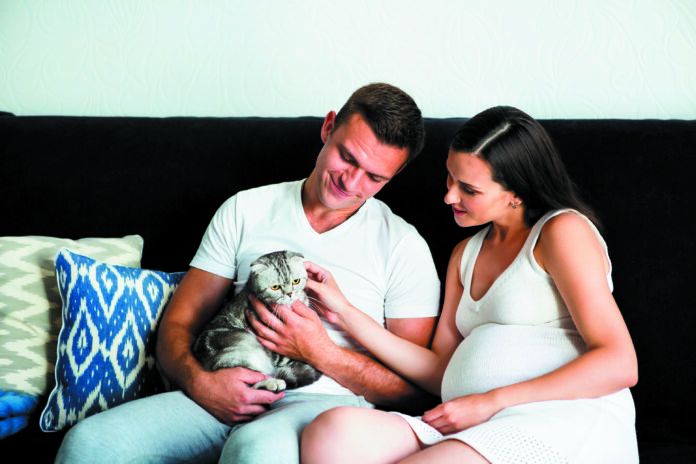You or someone in your household is expecting — congratulations! But don’t expect your cat to be thrilled. A lot of cats do not accept change very well, and a new addition to the home who will sometimes be noisy and shift the focus of attention may not be taken in stride by your pet. Fortunately, there’s a lot you can do during the pregnancy to help acclimate your cat to the impending arrival. Involve your pet’s senses.
Sound. Play tapes of baby noises — gurgling, crying, cooing — so your cat will become used to the new sounds he is going to be hearing.
Scent. Rub baby lotion on your hands just before you engage in a pleasant activity with your cat so he’ll come to associate the odor of the lotion with positive experiences.
Sight. Set up at least some of the baby furniture ahead of time so that your pet can get used to the fact that what might have been a guest room or study will now contain different furniture for a different use.
Touch. About a month before the baby is born, any surfaces that you don’t want the cat on should be made unappealing. For instance, if you have set up a changing table, put cardboard over it that you cover with double-sided masking tape. Cats generally do not like sticky surfaces.
If once the baby arrives someone else will be doing the lion’s share of the cat care — feeding, playing, and so on — routines should be handed over to the new caregiver in advance. A month or two ahead of the baby’s arrival, the new cat nanny (canny?) should start to take over the duties of putting out your pet’s food, grooming him, and engaging with him more often. That way, the cat won’t have to adjust to the new baby and the handoff of tasks at the same time.
When the baby comes home
When the baby arrives home from the hospital, the new mother should greet the cat peacefully in a quiet room without interruption, as she will have been away for a couple of days. Once she has had a few minutes to reconnect, others can be let in.
Put a receiving blanket or other item the baby has worn in a place that the cat can sniff and investigate it. That’s an important way for your pet to become acquainted with the new member of the household. If your cat is intrigued by the tiny newborn, it’s also okay to let him sniff the baby while someone is holding her.
Make sure the crib and other locations where the baby sleeps are absolutely off-limits to the cat. A crib or bassinet might prove very alluring for a cat, with its warm blanket, cozy feel, and the smell of milk. But a newborn cannot even really turn her head, let alone turn over, and a heat-seeking cat who wants to snuggle next to the baby’s head for warmth can make it difficult for her to breathe. If the cat decides to land on the baby’s chest while jumping into the crib, it could also wreak havoc on her weak chest muscles, not to mention do other damage. That’s why you should close the door to the nursery while the baby is napping. If there is no door, install a temporary screen door or place a tent over the crib to keep the cat out of it. Separating your sleeping infant from the cat is that important. The ASPCA points out that this measure will also keep your cat from urinating in the crib, something he may do if he is feeling very stressed.
Even when the baby is awake, she and the cat should never be left alone together. A helpless newborn is no match for the claws and teeth of a cat who may very well not grasp the importance of the tiny being in front of her.
Finally, do make time to play with the cat, not only when the baby is asleep but also when she’s awake. The cat needs to know that she still counts, and not only when the baby is “out of the way.” Cats don’t necessarily emote in ways that we can easily understand, but a cat who’s given short shrift when a new baby arrives home absolutely can end up feeling neglected.




